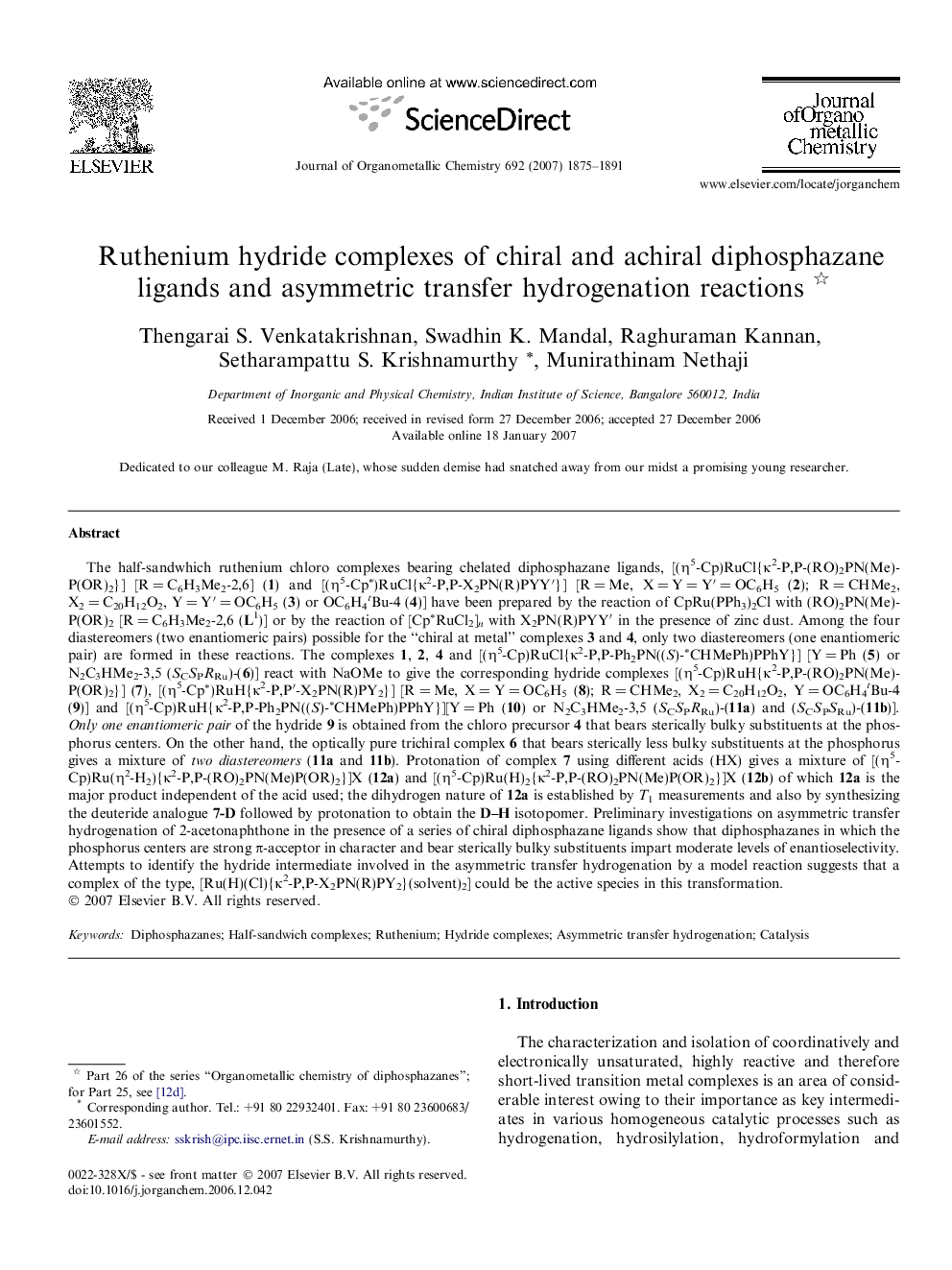| کد مقاله | کد نشریه | سال انتشار | مقاله انگلیسی | نسخه تمام متن |
|---|---|---|---|---|
| 1325475 | 977386 | 2007 | 17 صفحه PDF | دانلود رایگان |

The half-sandwhich ruthenium chloro complexes bearing chelated diphosphazane ligands, [(η5-Cp)RuCl{κ2-P,P-(RO)2PN(Me)P(OR)2}] [R = C6H3Me2-2,6] (1) and [(η5-Cp∗)RuCl{κ2-P,P-X2PN(R)PYY′}] [R = Me, X = Y = Y′ = OC6H5 (2); R = CHMe2, X2 = C20H12O2, Y = Y′ = OC6H5 (3) or OC6H4tBu-4 (4)] have been prepared by the reaction of CpRu(PPh3)2Cl with (RO)2PN(Me)P(OR)2 [R = C6H3Me2-2,6 (L1)] or by the reaction of [Cp∗RuCl2]n with X2PN(R)PYY′ in the presence of zinc dust. Among the four diastereomers (two enantiomeric pairs) possible for the “chiral at metal” complexes 3 and 4, only two diastereomers (one enantiomeric pair) are formed in these reactions. The complexes 1, 2, 4 and [(η5-Cp)RuCl{κ2-P,P-Ph2PN((S)-∗CHMePh)PPhY}] [Y = Ph (5) or N2C3HMe2-3,5 (SCSPRRu)-(6)] react with NaOMe to give the corresponding hydride complexes [(η5-Cp)RuH{κ2-P,P-(RO)2PN(Me)P(OR)2}] (7), [(η5-Cp∗)RuH{κ2-P,P′-X2PN(R)PY2}] [R = Me, X = Y = OC6H5 (8); R = CHMe2, X2 = C20H12O2, Y = OC6H4tBu-4 (9)] and [(η5-Cp)RuH{κ2-P,P-Ph2PN((S)-∗CHMePh)PPhY}][Y = Ph (10) or N2C3HMe2-3,5 (SCSPRRu)-(11a) and (SCSPSRu)-(11b)]. Only one enantiomeric pair of the hydride 9 is obtained from the chloro precursor 4 that bears sterically bulky substituents at the phosphorus centers. On the other hand, the optically pure trichiral complex 6 that bears sterically less bulky substituents at the phosphorus gives a mixture of two diastereomers (11a and 11b). Protonation of complex 7 using different acids (HX) gives a mixture of [(η5-Cp)Ru(η2-H2){κ2-P,P-(RO)2PN(Me)P(OR)2}]X (12a) and [(η5-Cp)Ru(H)2{κ2-P,P-(RO)2PN(Me)P(OR)2}]X (12b) of which 12a is the major product independent of the acid used; the dihydrogen nature of 12a is established by T1 measurements and also by synthesizing the deuteride analogue 7-D followed by protonation to obtain the D–H isotopomer. Preliminary investigations on asymmetric transfer hydrogenation of 2-acetonaphthone in the presence of a series of chiral diphosphazane ligands show that diphosphazanes in which the phosphorus centers are strong π-acceptor in character and bear sterically bulky substituents impart moderate levels of enantioselectivity. Attempts to identify the hydride intermediate involved in the asymmetric transfer hydrogenation by a model reaction suggests that a complex of the type, [Ru(H)(Cl){κ2-P,P-X2PN(R)PY2}(solvent)2] could be the active species in this transformation.
Ruthenium(II) hydride complexes of chiral and achiral diphosphazanes and preliminary investigations on ruthenium catalyzed asymmetric transfer hydrogenation of 2-acetonaphthone in the presence of chiral diphosphazanes are reported.Figure optionsDownload as PowerPoint slide
Journal: Journal of Organometallic Chemistry - Volume 692, Issue 10, 15 April 2007, Pages 1875–1891